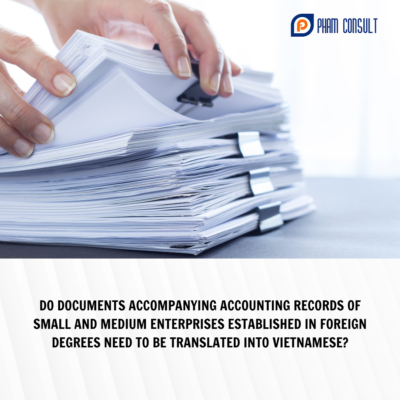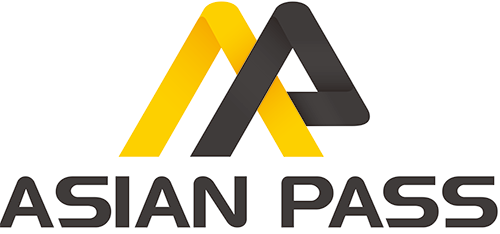Accounting documents are the records used as a basis for recording various accounting transactions. Therefore, accountants need to have a clear understanding of what accounting documents are. The question is whether the accompanying documents of accounting records of small and medium-sized enterprises (SMEs) prepared in a foreign language need to be translated into Vietnamese. In the following article, Pham Consult will provide answers to these questions.

1. What are accounting documents?
– What are accounting documents
According to Article 3, Clause 3 of the Accounting Law of 2015, accounting documents refer to papers and materials that reflect the occurrence and completion of financial and economic transactions, serving as a basis for recording in accounting books.
The accounting documents are prepared in accordance with the sequence, procedures, and forms prescribed by law. Based on Article 16 of the Accounting Law of 2015, the accounting documents must contain the following essential contents:
– Document number
• Name, address, and phone number of the enterprise, organization issuing the document, and the receiving enterprise or organization.
• Document title
• Date of document issuance (day, month, year)
• Description of the generated economic transaction
• Quantity of goods, unit price, total amount in numerical form, and the total payment amount in both numerical and written form for the economic transaction.
• Signatures of the document preparer and relevant parties on the document.
Examples of accounting documents:
- Payment documents: receipts, payment vouchers (for cash payments), debit notes, credit notes, bank statements (for transfer payments),…
- Employment and salary-related documents: attendance records, payroll statements, salary advance forms,…
- Inventory-related documents: inventory receipts, inventory withdrawals, material and tool allocation sheets,…
- Sales and purchase documents: value-added tax invoices, purchase and sales invoices, sales and purchase registers,…
2. Are accounting documents of small and medium-sized enterprises (SMEs) allowed to be prepared multiple times?
The accounting documents of small and medium-sized enterprises (SMEs) are regulated under Clause 1, Article 85 of Circular 133/2016/TT-BTC as follows:
The accounting documents are to be prepared and signed.
- Accounting documents must be prepared for all economic and financial transactions related to the business activities of the enterprise. Each economic or financial transaction should have only one accounting document.
- Accounting documents must be prepared clearly, completely, promptly, and accurately according to the prescribed format. In cases where there is no prescribed format, the accounting unit is allowed to design its own accounting document template, but it must ensure that all the required contents as stipulated by the Accounting Law are included.
- The content of the economic and financial transactions on the accounting documents must not be abbreviated, erased, or altered. When writing, ink pen should be used, and numbers and words should be written continuously without interruption. Blank spaces should be crossed out. Any accounting document that has been erased or altered will not be valid for payment or accounting purposes. In case of an error in an accounting document, it should be canceled by crossing it out with a diagonal line.
…
According to the regulations, accounting documents of small and medium-sized enterprises (SMEs) should only be prepared once for each economic or financial transaction.
3. The signatures on accounting documents of small and medium-sized enterprises must be signed with what type of ink?
The signatures on accounting documents of small and medium-sized enterprises are regulated under Clause 5, Article 85 of Circular 133/2016/TT-BTC as follows:
The accounting documents are to be prepared and signed.
…
- Accounting documents must be prepared with the required number of copies as specified. In cases where multiple copies of accounting documents are required for a single economic or financial transaction, the content of the copies must be identical.
- Accounting documents must contain the necessary signatures according to the designated positions on the documents. Signatures on accounting documents must be made with non-fading ink. It is not allowed to sign accounting documents with red ink or pre-engraved signature stamps. The signatures on accounting documents must be consistent. The person responsible for preparing, approving, and other signatories on accounting documents are accountable for the content of the accounting documents.
- For businesses that do not have a chief accountant position, a designated person must be assigned to handle accounting transactions with customers, banks, etc. The signature of the chief accountant can be substituted with the signature of the person in charge of accounting for that entity. The person in charge of accounting must fulfill the responsibilities and rights as stipulated for the chief accountant.
- Signatures on accounting documents must be made by authorized individuals or individuals who have been delegated the authority to sign. It is strictly prohibited for authorized individuals or delegated signatories to sign accounting documents before the documents have been recorded or contain incomplete content according to the signatory’s responsibility.
…
According to the regulations, the signatures on accounting documents of small and medium-sized enterprises must be signed with non-fading ink.
It is not allowed to sign accounting documents with red ink or pre-engraved signature stamps.
4. Do documents attached to accounting documents of small and medium-sized enterprises prepared in foreign languages need to be translated into Vietnamese?
The regulations regarding accompanying documents to accounting documents are specified in Article 87 of Circular 133/2016/TT-BTC as follows:
Translate accounting documents into Vietnamese, use, manage, print and issue accounting document formsAccounting documents recorded in foreign languages, when used to record accounting books and prepare financial reports in Vietnam, must have the main contents specified in the Accounting Law translated into Vietnamese.The accounting unit must be responsible for the accuracy and completeness of the content translated from foreign languages into Vietnamese. The documents translated into Vietnamese must be attached to the original in a foreign language.Documents accompanying accounting documents in foreign languages such as contracts, documents accompanying payment documents, investment project documents, settlement reports and other related documents do not have to be translated. Vietnamese unless requested by a competent State agency.Businesses can purchase ready-made templates or design and print them themselves, but must ensure the main contents of the documents specified in the Accounting Law.Documents must be carefully preserved and must not be damaged or rotten. Checks and valuable papers must be managed like money. Businesses that use electronic documents for economic, financial and accounting activities must comply with the provisions of legal documents on electronic documents.Thus, according to regulations, for documents accompanying accounting documents of small and medium-sized enterprises prepared in foreign languages such as contracts, documents attached to payment documents, investment project documents, etc. Investments, settlement reports and other related documents do not have to be translated into Vietnamese unless requested by a competent State agency.
Through the above article, Pham Consult has answered for you whether documents accompanying accounting documents of small and medium-sized enterprises prepared in foreign languages need to be translated into Vietnamese? Hope the above information will help your work.




 VI
VI